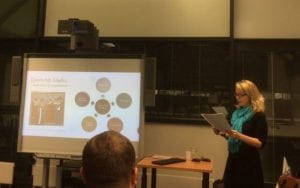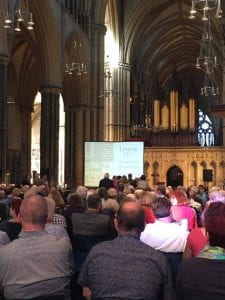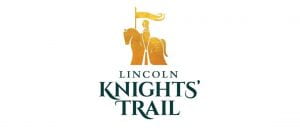The Medieval Studies Research Group is delighted to announce that two students from the School of English and Journalism, Abigail Laycock and Elizabeth Egan, supervised by our own Dr Renee Ward and Mrs Claire Arrand, have been awarded the Dean’s Choice Award from the Dean of Lincoln Academy of Teaching and Learning (LALT), Dr Kate Strudwick, for their Undergraduate Research Opportunities Scheme (UROS) project, ‘Excavating the Archives: Making Lincoln Cathedral Library’s Middle English Manuscripts Accessible’. Over the summer, Lily and Abbie undertook research on the archive’s collection of manuscripts in or with Middle English texts and prepared materials (text and image) that will be housed on University Library’s Special Collections LibGuide as well as on the Lincoln Cathedral Library’s website, making the content available to both public and academic audiences. To read more about the project, please follow the link here. The award is a splendid achievement and reflects the University’s close relationship enjoyed by its staff and students with Lincoln Cathedral and its collections.
What’s in a name? A blog by Annabelle Mansell
What happens when we focus our attention on people who aren’t named in our sources? This is the question that one of our undergraduate students has grappling with over the summer. Annabelle Mansell, a second-year Classical Studies student who had been successful in securing a bursary from the Undergraduate Research Opportunities Scheme (UROS), worked with Hope Williard and Jamie Wood on a project called ‘Invisible Agents: Networks of Learning in Late Antiquity’. Annabelle has written a blog post on the experience:
The aims of this project were to begin to understand how low-status, often unnamed individuals functioned within the broader educational network of Late Antiquity. We examined many of the letters of one well-connected teacher, Libanius, and transferred the key relationships discussed into an Excel spreadsheet, which allowed the creation of visual depictions of Libanius’ networks through graphs. With the information being presented in this digital, visual format, it is possible to do specific enquiries into Libanius’ networks. For example, one could see the centrality of an unnamed pedagogue (an enslaved person entrusted with overseeing the education of their master’s children) within a given family cluster by looking at a specific dossier of letters, or one could investigate the changing shapes of the network chronologically. The data being in this form allows for further investigations and a visual presentation of relationships which was not immediately available before. The graphs that have been generated already from the research begin to show how unnamed individuals’ centrality within a network can shift depending on the size of networks, and have begun to reveal more about the nature of the positions of and attitudes towards pedagogues. This project has started to lay the foundation for this area of enquiry, illustrating the value in transferring texts into data that can support visualisations.
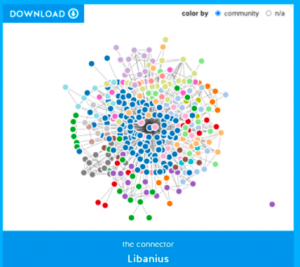
This project presented unanticipated challenges. Learning how to operate Microsoft Excel and ConnectTheDots took more time than expected, and technical issues caused large losses of data on multiple occasions, which massively delayed progress. This had an impact on how targets were set and achieved, as I had to learn to create a flexible schedule which allowed for surprise setbacks. A second issue was the large quantity of data available to me throughout this project, making it difficult to complete analysis of all of the letters that I had initially planned.
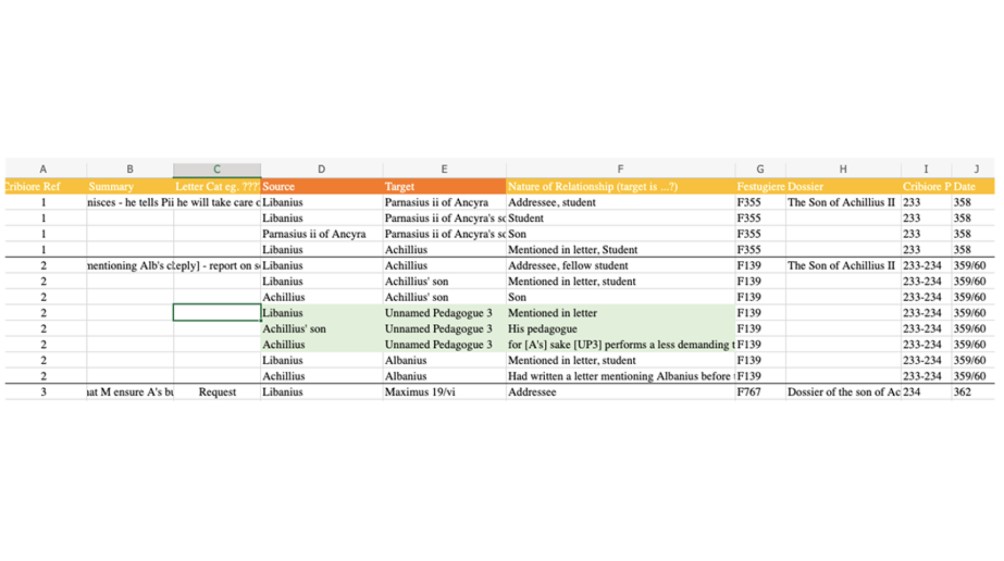
My supervisors have been invaluable to me throughout this project. The wealth of experience and knowledge they possess (both regarding Late Antiquity and the procedures of research) have been a huge help, and without their guidance and support I could not have achieved as much as I did. Our meetings were always beneficial and encouraging, and even when I was struggling most I was flooded with support and further avenues to explore. It has been a privilege to work on this project together, and an invaluable introduction to collaborative research.
This experience has been a unique opportunity which has allowed me to explore areas I am interested in pursuing further, as well as introducing me to new ideas and burgeoning approaches to handling historical textual data. I have gained technical skills in digital literacy and network analysis tools such as ConnectTheDots. This experience will help with my future study as I have learnt how to extract important data from texts efficiently, and how to use more visual methods to analyse it. It has given me ideas for further possible related research and applications for this data, as we could use it to create maps and timelines, as well as more expansive graphs.
Please click here to download a poster about Annabelle’s project: Annabelle Mansell – poster
Medieval Christmas
The Christmas of 2017 has finished and what a year it has been! I graduated from the University of Lincoln in September and started my MA in Medieval Studies later that month. The first semester has been brilliant. In our Research Methods module, we discussed questions I had never properly considered before. Another module, Saints and Scholars, introduced me to the engaging world of medieval hagiography, through which I examined the truly fascinating case study of Sainte Foy of Conques, that became the focus of my last research project. And last but not least, Medieval Latin has been a rewarding challenge (more on that to come soon in another post).

With the festive period just gone, I’ve been thinking about Christmas celebrations in the medieval period. I remember that this curiosity became prominent at the beginning of December, when I went to the Medieval Christmas Market in Lincoln. The market is always an enjoyable experience and it takes place in the beautiful Bishop’s Palace. But I do always wonder how “Medieval” all this really is…
Despite the fact that the market’s contents have nothing medieval about them (or perhaps a vague stylistic inspiration) the atmosphere of merriment and cheer was an element of winter festivities inherited from the pre-Christian, which continued throughout the Middle Ages. This is an interesting aspect that Alexander Murray discussed in History Today (1986).
Murray explained how Christianity adopted and adapted existing pagan feasts celebrating the winter solstice to take control of seasonal festivities. The winter solstice has been celebrated since ancient times. From the creation of the Julian Calendar in 46 BC the celebrations have fallen on 25th December. The Bible does not disclose the exact day of Christ’s birth so it is easy to see why the Feast of the Nativity, first recorded in 336, took place on 25th December.
As Christianity started to take part in winter celebrations it would adopt aspects of pre-existing seasonal feasts. Murray cites three feasts as the major influences for Christian Christmas. The first is the Saturnalia, which celebrated Saturn in late December. Another was Kalends, which took place on 1st January for high officials taking office that year. Both of these were of a roman imperial nature, celebrating pagan gods and the bureaucratic structures of empire respectively, which allowed their customs to be more easily adopted because the imperial identity transcended ethnicity, geographical origin and religion. The third feast that influenced Christian Christmas was Yule, celebrated outside the Empire meaning it was rooted more in paganism, Christianity’s main competitor at the time.
The roots of medieval and modern Christmas can be found in these feasts. Presents were given at both imperial feasts. Greenery was used as festive decorations at all of them; evergreens in the south and conifers in the north. With Saturnalia, Kalends and Yule being feasts food took centre stage. Special pies and cakes were present at Saturnalia and Yule. The Yule boar was a centrepiece in Northern Europe, Turkey would arrive in 1531 from Mexico. The Christmas feasts of the high orders in the Middle Ages could get excessive, for example, at Richard II of England’s court in 1377 28 oxen and 300 sheep were eaten.

Christianity created a whole festive period centred around the Nativity feast with Advent in place by 500 and other feasts, such as that of St. Nicholas, also taking place in December. In the Carolingian chronicle of 829 Louis the Pious had a 57 day period of festivity dating from St. Martin’s day until Epiphany had passed on 6th January.
During the medieval period Christian Christmas absorbed elements of pre-Christian feasts and built up a winter festive season which used food, decorations and presents to create a sense of social harmony and cheer, an atmosphere which is replicated with the assortment of gifts, food and drink that are at the heart of Lincoln’s Medieval Market as well as modern Christmas in general.
Further Reading
Cabaniss, Allen. ‘The Christmas of 829’, Chuch History 43:3 (1974), 304-307.
Murray, Alexander. ‘Medieval Christmas’, History Today 36: 12 (1986), 31-39.
Dr Elena Woodacre: ‘Is it all about the Money? Joan of Navarre and the economic element of Queenship’
The recent engagement of Meghan Markle to Prince Harry has sparked media interest internationally and the much discussed event has also contributed to women belonging to (or entering) the British Royal Family being in the public gaze once again. The success and popularity of historical dramas focusing on modern queens, such as Victoria and the newly released second season of The Crown, confirm how much modern audiences are fascinated by the subject.
Perfect timing then, on Wednesday 6th December, to host Dr Elena Woodacre (University of Winchester) at the last History and Heritage research seminar of the semester, who presented her research on Queen Joan of Navarre (1370-1437). Dr Woodacre discussed the economic activity of Joan, wife to Henry IV, especially regarding her dower. In her paper, Dr Woodacre examined what exactly constituted Joan’s dower; whether and how she managed to attain (through constant struggle) the correct amount due to her as a queen, and how she spent her money.

All these aspects demonstrated how significant Joan’s economic activity was to the royal court. It certainly had an impact on the kings’ politics, an example being Joan’s imprisonment from 1419 to 1422 after being accused of necromancy by her own step-son Henry V, who was most likely motivated by financial need.
As an MA student in Medieval Studies, I found this paper particularly fascinating and enlightening for the ways in which the selection of sources presented by Dr Woodacre made me consider and re-assess a range of approaches to medieval economics. The analysis of Joan’s household accounts, which show annual expenditure, shed new light on the behaviour, personal relationships, networks and ways of operating of Joan as a queen, but also as an individual.
Dr Woodacre’s truly engaging paper demonstrated that the accurate examination of queens’ economic activity allows historians to get an insight into a wide range of aspects concerning their personal connections, political strategies and modes of behaviour, which perhaps one might not expect to gather from account books. Thank you, Dr Woodacre, for such a valuable lesson, worth applying to the study of queenship and beyond.
Completed MA Medieval Studies
This week marks the end of my MA Medieval Studies course at the University of Lincoln, and I cannot believe it has gone so quickly.
On Friday 15th September, me and my course-mates handed in our independent projects and said goodbye to the university campus. I am already looking forward to graduating in January so our MA class can meet up again, we became such a close knit group this year!
While I am sad to be leaving Lincoln, it was an excellent feeling to hand in that hefty 83-page long study to the submission office!
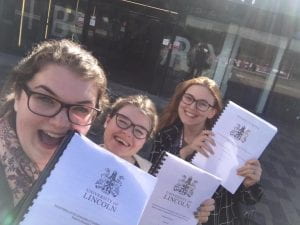
On behalf of my course-mates I would like to say thank you to our personal tutors and the medieval department in the School of History and Heritage for supporting us throughout our studies, and helping us to put 20,000 words of dissertation to paper!
Tablet Weaving – ‘Medieval Week’ at The Collection

As part of their Medieval Week, The Collection Museum offered several arts and crafts workshops to engage children with medieval history.
Despite being more than a decade older than their intended audience, myself and two other MA Medieval Studies students went along to a tablet weaving workshop at The Collection and had a great time!
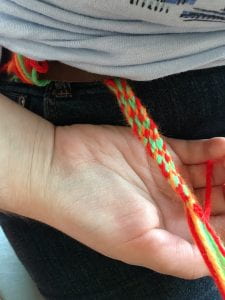
According to our workshop instructor, tablet weaving (or hand weaving) has a long history in the textile world and was particularly prominent in the middle ages. The finished braids were used to decorate the edges of clothing and to denote social rank.
The tablets or cards were made of wood, bone or antler; they were square or slightly rectangular in shape and had four holes in each corner. The yarn would be threaded through these holes, and the weaver would pass a shuttle through the yarn to start weaving.
It is a very therapeutic process!
Dr Thomas Asbridge – Lincoln 1217: The Battle that Shaped History
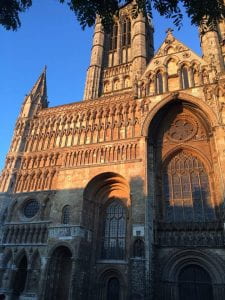
On Friday evening, Dr Thomas Asbridge (Queen Mary University of London) gave a lecture in the Nave of Lincoln Cathedral, explaining how the veteran commander and fabled knight William Marshal defeated the French and their baronial allies in the decisive encounter played out within Lincoln’s medieval walls 800 years ago.
Knowing very little about the Battle of Lincoln myself, this lecture provided the perfect introduction to the 1217 battle waged on the streets of Lincoln. I especially appreciated how Dr Asbridge traced the broader impact of the Battle of Lincoln, from the reissuing of Magna Carta to the birth of English national identity, situating the battle within a context that I was more familiar with.
It was fascinating to hear Dr Asbridge present in person, as I immensely enjoyed his documentary series, The Crusades, on BBC Two.
Dr Asbridge is also the historical consultant behind Lincoln’s 2017 Battles & Dynasties exhibition in The Collection which I am looking forward to viewing in the near future.
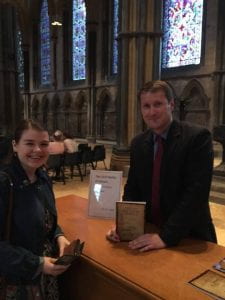
After the lecture, Dr Asbridge was kind enough to sign a copy of the booklet he wrote in celebration of the 800th anniversary of the Battle of Lincoln.
Lincoln Knights’ Trail 2017
This weekend, Lincoln Knights’ Trail opened in celebration of the 800th anniversary of the Battle of Lincoln and the sealing of the Charter of the Forest.
There are 36 sculptures in total placed across Lincoln City Centre and each Knight has been designed and painted by a different artist. (To find out more about the Knights’ trail artists, please click here.)
I did not know anything about the Battle of Lincoln prior to this event, but the Knights’ Trail website has provided a short breakdown of the major events surrounding this period of Lincoln’s history:
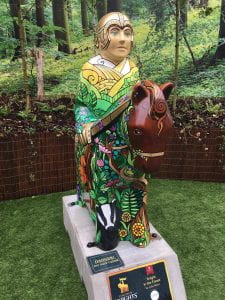
‘After agreeing the Magna Carta in 1215, King John went back on his promise which led the country to fall into a civil war. This divided the barons between supporting the crown and rebel barons who invited Prince Louis, the son of the French King, to take the English throne.
In October 1216, King John died and his son, Henry III, was only a child so William Marshal, a famous medieval knight and the King’s champion, acted as regent. By May 1217, much of the country had been taken by the combined French and rebel English forces, but Lincoln Castle held out for the royalist cause under the command of a formidable lady constable, Nicola de la Haye.

On the morning of 20 May 1217, the Royalist army set out from Stowe or Torksey (the sources disagree) to help Nicola and raise the siege. The Royalists broke into the city and in the fighting that followed between the castle’s East Gate and Lincoln Cathedral, the siege of the Castle was lifted and the French commander was killed. The rebels then either surrendered or fled down the hill and towards London. The Royalists claimed victory and then sacked the city. One chronicler ironically nicknamed the battle the ‘Nine-day’ of Lincoln (a Nine-day was either a fair or a tournament) as a battle in the city in 1141 had already been given the title of The Battle of Lincoln.
This battle was of national significance. If the Royalists had lost, England would have become part of France and our King Louis VIII, instead the Plantagenet dynasty ruled for another 250 years.
The 1217 battle and the subsequent defeat of a French naval force at the Battle of Sandwich in August meant Louis’ attempt to become King of England was over. On the 6th of November 1217 Marshal, in the name of the young Henry, reissued Magna Carta in an attempt to reunite the country and with it a companion document called the Charter of the Forest. In contrast to Magna Carta, which mainly dealt with the rights of barons, it confirmed rights of access to royal forests for all men and was not superseded until 1971.’ (Credit: Dr Erik Grigg, Lincoln Knights’ Trail Website)
Both the 1215 Magna Carta and the 1217 Charter of the Forest can still be viewed in Lincoln Castle and the Knights’ Trail sculptures will remain in position until 3rd September 2017.
I am looking forward to seeing all of the Knights’ Trail now that the weather is getting warmer!
Prof. Peter Stone: ‘The protection of cultural property in the event of armed conflict’

On Wednesday 10th May, we were joined by Professor Peter Stone (Newcastle University) for the last History and Heritage research seminar for this academic year. Professor Stone’s presentation discussed the history of cultural property protection and outlined the work of the Blue Shield (the so-called “cultural equivalent” of the Red Cross), suggesting that if we are proactive, cultural property need not be an unwitting casualty of conflict.
This seminar was  fascinating and made me think about the logistics of preserving history for future generations, not just in war zones (although, as Professor Stone suggests, this is important) but at local levels too. Many of the MA students in attendance at this seminar, myself included, are particularly interested in making ‘ordinary’ people aware that our culture heritage is everywhere and deserves to be protected. So, while his presentation was not directly focused on medieval history, Professor Stone raised some highly important points concerning the protection of cultural property.
fascinating and made me think about the logistics of preserving history for future generations, not just in war zones (although, as Professor Stone suggests, this is important) but at local levels too. Many of the MA students in attendance at this seminar, myself included, are particularly interested in making ‘ordinary’ people aware that our culture heritage is everywhere and deserves to be protected. So, while his presentation was not directly focused on medieval history, Professor Stone raised some highly important points concerning the protection of cultural property.
Thank you, Professor Stone, for your thought provoking presentation!
Dr Eduardo Manzano Moreno at the University of Lincoln
Thanks to the generosity of the Santander Fund, the University of Lincoln is hosting the first two of what we hope will be an annual round of visiting fellows in medieval Iberian history: Dr Julio Escalona Monge and Dr Eduardo Manzano Moreno, both of the CSIC (the National Research Council) in Madrid, have visited Lincoln and each to ran a workshop and deliver a public lecture on aspects of their research and the study of medieval Iberia more broadly.
I attended the workshop and lecture ran by Dr Eduardo Manzo Moreno on Thursday 4th May.

Matching Facts and Artefacts: Multidisciplinary Approaches to the Study of Medieval Iberia
In this workshop, Dr Manzo Moreno examined the integration of the material and the textual record, and the manifold ways in which both can be related.
I found his research on how artefacts from 8th-10th century Al-Andulus provide an insight into contemporary networks of knowledge and intellectual genealogy particularly fascinating.
His exploration of Islamic manuscripts and biographical dictionaries was also very interesting, and acted to further illuminate how knowledge circulated in this time period.

Convivencia: Jews, Christians, and Muslims; or, how we have failed to tackle multiculturalism in medieval Iberia from a social perspective
In this lecture, Dr Eduardo Manzo Moreno highlighted the importance of multiculturalism as a historiographical focus and demonstrated how we can address the subject of multiculturality in Medieval Iberia.
His methodology raised an interesting debate in the Q&A session afterwards, and it was a pleasure to listen to Dr Manzo Moreno speak about his research.
